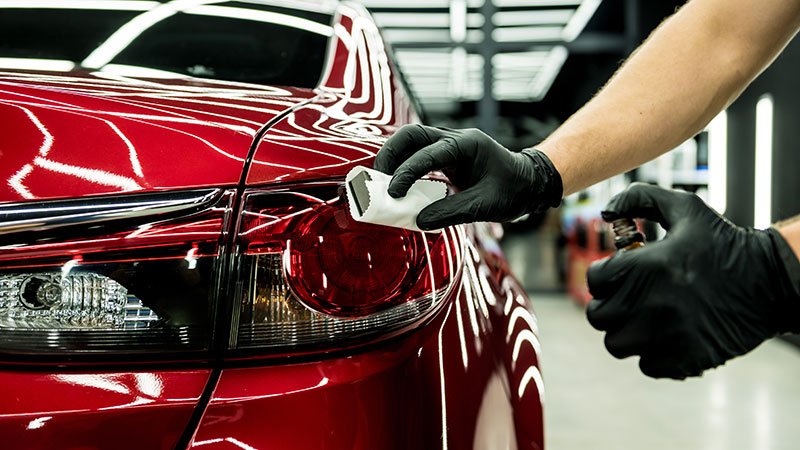Exactly How Ceramic Coating Philadelphia Guards Against UV Rays and Ecological Damage
Exactly How Ceramic Coating Philadelphia Guards Against UV Rays and Ecological Damage
Blog Article
Why Ceramic Finishing Is the Ultimate Service for a Perfect Finish
Ceramic coating has become a leading remedy for those seeking a flawless finish for their cars, thanks to its remarkable resilience and protective functions. This innovative liquid polymer not only bonds perfectly with factory paint but likewise uses a formidable obstacle against usual threats such as scrapes, UV rays, and environmental contaminants. Its hydrophobic homes streamline upkeep while improving visual appeal. Nonetheless, recognizing just how this modern technology contrasts to standard techniques and discovering its application nuances can disclose a lot more about its value. What variables absolutely set ceramic finishing apart?
What Is Ceramic Coating?

When applied properly, ceramic layer creates a hydrophobic surface that drives away water and dust, making it simpler to preserve and clean. Unlike traditional waxes or sealants, which normally use brief protection, ceramic coverings can last for a number of years, depending on the item high quality and application approach. The procedure of using ceramic coating needs meticulous preparation, consisting of detailed cleaning and in some cases repaint modification, to make certain optimum bonding and efficiency.
Ceramic layers are not limited to auto surfaces; they can also be used on different materials, including glass, steel, and plastics, supplying a flexible remedy for improving defense. In general, ceramic coating represents a considerable advancement in surface protection technology, incorporating both aesthetic and functional advantages for a wide variety of applications.
Benefits of Ceramic Layer
While numerous surface area defense options exist, the advantages of ceramic covering stand apart as a result of its distinct residential properties and durable performance. One of the primary advantages is its extraordinary toughness. Ceramic Coating Philadelphia. Unlike standard wax or sealants that call for regular reapplication, ceramic coverings offer a resilient layer that can last for numerous years, significantly reducing upkeep efforts
An additional significant advantage is improved defense versus environmental impurities. Ceramic finishings develop a hydrophobic surface that pushes back water, dust, and various pollutants, making it simpler to clean up. This feature not just maintains the automobile's appearance yet likewise minimizes the threat of corrosion and oxidation, especially in harsh weather.
In addition, ceramic finishings offer exceptional resistance to UV rays, avoiding fading and degradation of paint gradually. This UV defense is vital for preserving the aesthetic worth of surfaces and lorries subjected to route sunlight.
Furthermore, the shiny coating accomplished with ceramic finishing enhances the general visual appeal, giving surfaces a showroom-quality sparkle. In general, ceramic finishings represent a substantial development in surface area defense technology, supplying enduring benefits that satisfy both aesthetic and useful demands.
Exactly How It Functions
Understanding the science behind ceramic finishings discloses how they give such impressive protection and longevity. At its core, a ceramic finishing is a fluid polymer that chemically bonds with the lorry's factory paint.
The application procedure entails multiple steps, consisting of surface prep work, which is vital to achieving optimum bond. When used, the finish goes through a curing procedure, throughout which it hardens and develops a semi-permanent bond with the paint surface area. This bond is what differentiates ceramic coverings from conventional waxes and sealers, offering a longer-lasting safety barrier that can endure for several years.
Additionally, the thickness of the layer can boost its safety qualities, ensuring that it can hold up against severe problems. Inevitably, the scientific research of ceramic coatings combines sophisticated materials with cutting-edge application strategies to provide an unparalleled degree of protection and visual improvement for automobiles.
Contrast With Conventional Techniques
When contrasted to from this source conventional paint security techniques such as waxes and sealers,The advantages of ceramic coatings end up being especially apparent. While waxes provide a short-lived sparkle, commonly lasting a couple of weeks to a couple of months, ceramic coverings provide a resilient protective layer that can endure for numerous years. This resilience substantially minimizes the regularity of reapplication, making ceramic finishings an extra affordable remedy in time.
Furthermore, standard methods commonly need comprehensive prep work and several applications to attain a sufficient degree of defense. check my source In comparison, ceramic layers bond at a molecular degree with the car's surface, developing a durable guard against ecological pollutants like UV rays, acid rainfall, and road salts. This bond improves the vehicle's resistance to scrapes and swirl marks, which prevail with standard waxes and sealants.
In addition, the hydrophobic residential or commercial properties of ceramic layers fend off water and dirt, causing less complicated cleaning and upkeep. On the other hand, wax and sealant-treated surfaces can attract gunk, necessitating even more frequent washing - Ceramic Coating Philadelphia. In general, ceramic layers not just supply superior protection yet likewise deliver a more visually appealing and long-lasting surface, developing them as the favored choice for critical automobile proprietors
Application and Maintenance Tips

Utilizing a foam applicator, apply the finish in small areas, complying with the manufacturer's standards regarding thickness and overlap. Permit enough curing time in between coats, normally 24 hours, to make sure proper bonding. After application, it is critical to prevent direct exposure to water or rough components for at least a week to enable the finishing to totally heal.
Additionally, utilizing a ceramic maintenance spray can improve the coating's hydrophobic residential or commercial properties and durability. Routine evaluations for any type of signs of wear will help maintain the finishing's honesty and preserve that excellent finish.
Verdict
In verdict, ceramic finish emerges as a premium option for achieving a remarkable automotive coating. By developing a durable bond with factory paint, ceramic coating effectively guards against scrapes, UV rays, and environmental pollutants.

Report this page